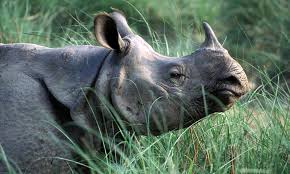Share this Article

Introduction
The one-horned rhinoceros (Rhinoceros unicornis), also known as the Indian rhinoceros, is one of the most iconic and endangered species in Nepal. Found primarily in the subtropical grasslands and forests of the Terai region, this magnificent creature is a symbol of Nepal’s rich biodiversity and conservation efforts. Once on the brink of extinction due to rampant poaching and habitat destruction, Nepal has made remarkable progress in protecting the one-horned rhino through stringent conservation measures and community involvement. Today, the rhino population in Nepal is a success story that highlights the country's commitment to wildlife conservation.
This article explores the history, habitat, threats, conservation efforts, and future challenges surrounding the one-horned rhinoceros in Nepal.
Historical Background
The one-horned rhinoceros has a deep historical and cultural significance in Nepal. Ancient texts, folklore, and artworks depict rhinos as majestic creatures, revered for their strength and uniqueness. Historically, rhinos roamed freely across the Terai region of Nepal, northern India, and parts of Bhutan and Bangladesh. However, excessive hunting during the British colonial era and Nepal’s unregulated hunting practices in the 19th and early 20th centuries drastically reduced their numbers.
During the early 20th century, Nepal’s rhino population declined to fewer than 100 individuals due to habitat destruction and poaching. The conversion of forests into farmlands and the expansion of human settlements further pushed rhinos to the brink of extinction. Recognizing the urgency of the situation, the Nepalese government and conservation organizations initiated various measures to protect and restore the rhino population.
Habitat and Distribution in Nepal
Nepal is home to one of the largest populations of one-horned rhinoceroses outside of India. The species primarily inhabits the floodplain grasslands, swampy areas, and riverine forests of the Terai region. The major rhino habitats in Nepal include:
1. Chitwan National Park
Established in 1973, Chitwan National Park is the most significant stronghold for Nepal’s rhino population.
It is home to over 700 rhinos, making it the primary conservation area for the species.
The park’s grasslands and wetlands provide an ideal habitat for rhinos, offering ample food sources such as grasses, fruits, and aquatic plants.
2. Bardia National Park
Rhinos were reintroduced to Bardia National Park in the 1980s to expand their range and reduce the risks of population concentration in a single area.
The park now supports a growing population of rhinos, contributing to species diversification and genetic health.
3. Shuklaphanta National Park
The smallest of Nepal’s rhino conservation areas, Shuklaphanta National Park, also serves as a habitat for translocated rhinos.
Efforts are ongoing to strengthen conservation initiatives in this region.
Threats to the One-Horned Rhino in Nepal
Despite Nepal’s conservation success, the one-horned rhino faces multiple threats:
1. Poaching and Illegal Wildlife Trade
Rhino horn is highly valued in illegal markets, particularly in China and Vietnam, where it is falsely believed to have medicinal properties.
Although Nepal has significantly reduced poaching through anti-poaching units and strict law enforcement, the threat still exists.
2. Habitat Loss and Degradation
Agricultural expansion, urbanization, and infrastructure development are leading to the destruction and fragmentation of rhino habitats.
Encroachment into national parks and forest corridors limits the space available for rhinos to roam and breed.
3. Human-Wildlife Conflict
As human settlements expand near rhino habitats, conflicts between rhinos and local communities have increased.
Rhinos occasionally venture into farmlands, damaging crops and causing economic losses, leading to retaliatory killings.
4. Climate Change and Natural Disasters
Rising temperatures, unpredictable rainfall patterns, and floods pose significant risks to rhino populations.
Flooding in Chitwan National Park has led to rhino drownings and habitat destruction in recent years.
Conservation Efforts in Nepal
Nepal has received international recognition for its outstanding efforts in rhino conservation. Several measures have contributed to the recovery and protection of the species:
1. Strict Anti-Poaching Strategies
Nepal has adopted a zero-tolerance policy against poaching.
The establishment of anti-poaching units, increased patrolling, and community involvement have helped curb illegal hunting activities.
The deployment of armed forest guards and the use of modern technology, such as drone surveillance and camera traps, have enhanced protection.
2. Translocation Programs
To ensure genetic diversity and reduce overpopulation stress in Chitwan National Park, rhinos have been relocated to Bardia and Shuklaphanta National Parks.
These translocation efforts aim to establish viable rhino populations in multiple regions of Nepal.
3. Community-Based Conservation Initiatives
Local communities play a crucial role in rhino conservation. Programs that involve indigenous groups in conservation efforts have been implemented.
co-tourism initiatives have provided local communities with alternative livelihoods, reducing dependency on forest resources and fostering a sense of ownership over wildlife conservation.
4. International Collaboration and Funding
Organizations such as the World Wildlife Fund (WWF), National Trust for Nature Conservation (NTNC), and International Union for Conservation of Nature (IUCN) have partnered with the Nepalese government to support rhino conservation.
Financial and technical assistance from international donors has strengthened Nepal’s conservation framework.
Success Stories and Population Growth
Nepal’s conservation efforts have yielded impressive results:
In 2015, Nepal achieved zero rhino poaching for a full year, a milestone celebrated globally.
According to the 2021 rhino census, Nepal’s rhino population increased to 752 individuals, up from 645 in 2015.
Chitwan National Park remains the most successful habitat, with an expanding rhino population contributing to the overall growth of the species.
Future Challenges and the Way Forward
Despite Nepal’s success in rhino conservation, future challenges remain:
1. Sustaining Conservation Gains
Maintaining zero poaching records requires continuous vigilance and resources.
Strengthening law enforcement and enhancing community participation will be crucial.
2. Expanding Habitat and Connectivity
Creating and maintaining wildlife corridors to connect different rhino habitats will ensure healthy population growth.
Preventing habitat fragmentation will require careful planning and policies to balance development and conservation.
3. Managing Human-Wildlife Conflict
Implementing compensation programs for farmers affected by rhino crop damage can reduce retaliatory killings.
Encouraging non-lethal deterrent methods to prevent rhino intrusion into human settlements.
4. Climate Adaptation Strategies
Developing flood mitigation measures and climate-resilient habitats will be essential to protecting rhinos from environmental threats.
Conclusion
The conservation of the one-horned rhinoceros in Nepal is a remarkable success story that demonstrates the power of dedicated efforts, strong law enforcement, and community involvement. From the brink of extinction to a steadily growing population, Nepal’s rhino conservation model serves as an inspiration for global wildlife protection. However, continuous efforts are necessary to address emerging challenges and secure a future where rhinos continue to thrive in their natural habitat. By safeguarding these magnificent creatures, Nepal is not only protecting its biodiversity but also preserving a vital part of its national heritage.
Categories:
Nature & Wildlife
Tags:
OneHornedRhino
,
SaveTheRhino
,
EndangeredSpecies
,
NepalWildlife







